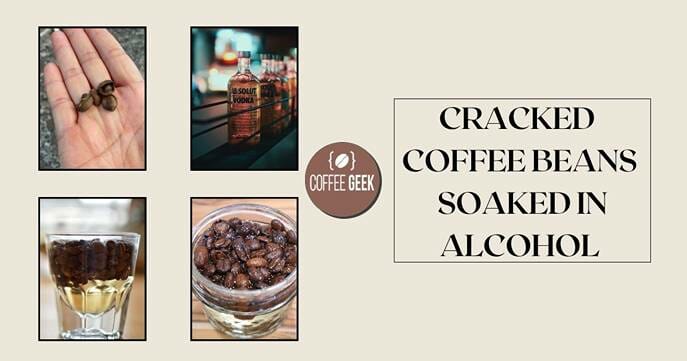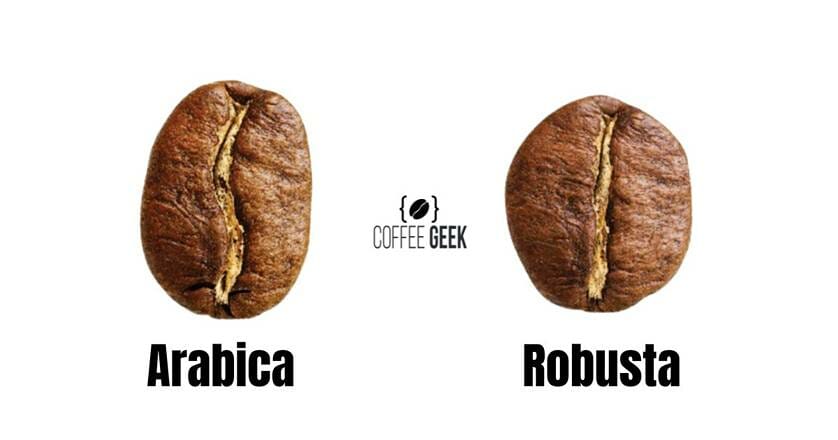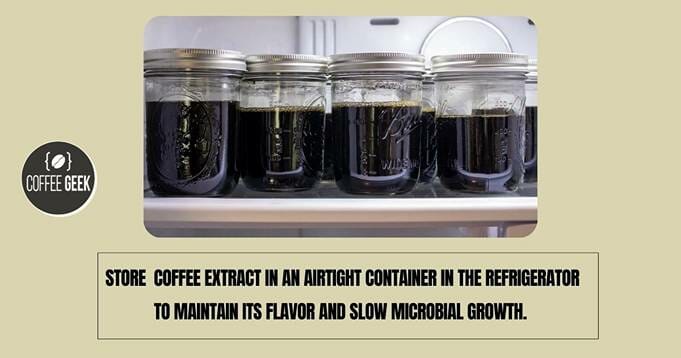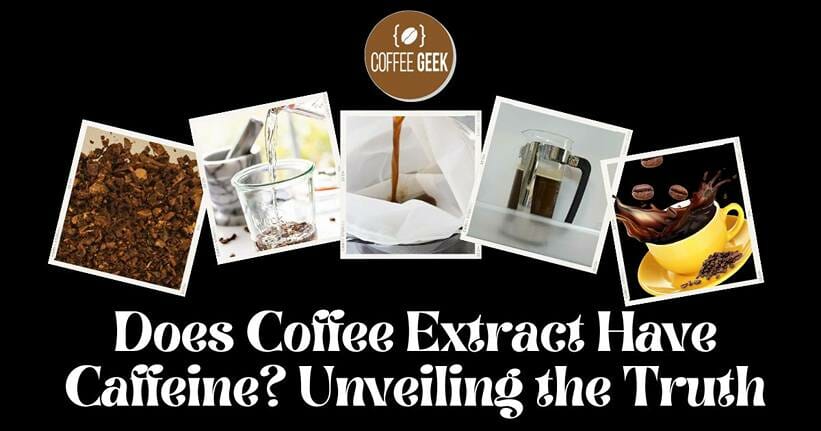As a coffee lover, I’ve always been curious about different ways to enjoy the rich flavor of coffee.
One method of drip coffee that has caught my attention recently is coffee extract, especially when it comes to its caffeine content.
In this article, we’ll explore does coffee extract have caffeine and the role it plays in delivering that rich coffee flavor in various applications.
Coffee extract is a concentrated form of coffee made from cracked or coarsely ground coffee beans soaked in alcohol for at least a week.
It is an essential ingredient in many baked goods and pastries, providing a robust coffee flavor to these treats.
I’ve been wondering whether this powerful flavor also carries a significant amount of caffeine, and upon research, I found that, indeed, coffee extract does contain caffeine.

Does Coffee Extract Have Caffeine – Key Takeaways
- Coffee extract does contain caffeine, making it a factor to consider for individuals sensitive to caffeinated products.
- The caffeine content in coffee extract can vary depending on factors such as the beans used and the extraction process.
- Health considerations and potential side effects should be taken into account when using coffee extract, especially for those with caffeine sensitivities.
Understanding Coffee Extract and Caffeine
Coffee Beans and Roasting Process

In my exploration of coffee extract, I discovered that it comes from coffee beans, which can be found in two primary varieties: Arabica beans and Robusta beans.
The flavor and caffeine content in these roasted coffee beans will depend on the roasting process. Generally, the darker the roast, the less caffeine there will be in the beans.
But when it comes to coffee extract, the caffeine content is determined more by the extraction method used rather than the roast.
Extraction Methods: Green Coffee Extract and Coffee Concentrate
I learned that there are various extraction methods used to obtain coffee extract, but two of the most common are green coffee bean extract and coffee concentrate.
Green coffee extract is made from unroasted coffee beans, which contain high levels of chlorogenic acids (antioxidants).
This extract is known for having less caffeine content than its roasted counterparts.
On the other hand, coffee concentrate extraction involves brewing coffee beans with hot water to create a strong liquid that can be diluted as needed.
The process for making green coffee beans extract into concentrate can vary, but it generally results in a product with higher caffeine content than green coffee extract.
It’s essential to understand that the amount of caffeine in coffee extract differs from brand to brand and depends on various factors, such as the type of bean, roast, and extraction method used.
To give you a better idea, sometimes green coffee bean extract may contain only around 20-50 milligrams of caffeine per fluid ounce, while coffee concentrate could have 100 milligrams or more.
In summary, coffee extract does contain caffeine, and its levels depend on the beans, roast, and extraction method.
Both green coffee bean extract and coffee concentrate extraction methods offer unique properties and flavors, making them versatile ingredients in a variety of products, from beverages to baked goods.
Caffeine Content in Coffee Extracts
Natural vs Artificial Extracts
In my experience, coffee extract does contain caffeine, with natural extracts having a higher concentration than artificial ones.
I’ve discovered that the amount of caffeine in coffee extract depends on factors such as the type of coffee beans and the coffee-to-alcohol ratio.
For instance, natural coffee extract derived from green coffee beans has around 3%-20% caffeine.
On the other hand, artificial extracts may contain little to no caffeine, as they are typically made of synthetic chemicals replicating the aroma and taste of coffee.
Decaf Coffee Extract
While regular coffee extract has varying caffeine content, there is also decaf coffee extract available for those who want the flavor without the stimulant.
Decaf coffee extract is created using processes that remove most of the caffeine from the beans before extraction.
However, it’s important to note that even decaf coffee bean extracts may still contain trace amounts of caffeine, though significantly less than their regular counterparts.
Stimulant Intake and Influence on Health
When using coffee extract as a flavoring or supplement, it’s essential to consider the caffeine content and its potential effects on our health.
Consuming caffeine has both benefits and side effects.
On one hand, caffeine is known to increase energy levels, boost fat metabolism, and provide antioxidants, which contribute to overall health benefits.
On the other hand, excessive caffeine intake may cause anxiety, affect cholesterol levels, and lead to other undesirable side effects.
To help control my caffeine intake, I pay close attention to the concentration of caffeine in my coffee extract.
For example, a teaspoon of some coffee extracts can have anywhere from 50 to 200 milligrams of caffeine, which is far more than a cup of instant coffee.
Instant coffee may have around 95 milligrams.
If I’m using the coffee extract for flavor, I try to seek lower-caffeine options or opt for decaf extracts when possible.
In conclusion, it’s important to be aware of caffeine content in coffee extracts and choose options that align with our personal preferences and health considerations.
By doing so, we can enjoy the rich flavor and benefits of coffee extract, without compromising our well-being.
Making and Storing Coffee Extract
Homemade Coffee Extract
Making coffee extract at home allows me to control the ingredients, customize the flavor, and manage the caffeine content from coffee beans.
To make my coffee extract, I begin with high-quality beans, preferably freshly roasted coffee beans.

My favorite method to create the extract involves a cold brew coffee technique:
- Coarsely grind 1 cup of coffee beans.
- Mix the coffee grounds with 2 cups of cold water in a large jar.
- Stir well, cover the jar, and refrigerate for 24 hours.
- After 24 hours, strain the coffee grounds using a fine-mesh strainer or cheesecloth.
- Store the resulting liquid in an airtight container.
This homemade coffee extract can be used as an alternative to brewed coffee or espresso powder in various recipes, such as desserts, marinades, or as an energy booster in my morning smoothie.
Shelf Life and Storage Guidelines
Proper storage of coffee extract is essential to maintain its freshness and prevent the growth of bacteria or mold.
Since my homemade coffee extract contains no added preservatives, its shelf life is shorter than store-bought varieties.

I store my coffee extract in an airtight container in the refrigerator to maintain its flavor and slow microbial growth.
This method typically allows the extract to retain its quality for approximately two weeks.
However, signs of spoilage, such as an off-smell, mold, or noticeable changes in texture, indicate it is no longer suitable for consumption.
If I require a longer shelf life or want to avoid potential bacteria growth due to added sugar, I have two options:
- Ethanol: Using a food-grade ethanol can help preserve my coffee extract for up to a year. Adding a small amount of alcohol, around 20% of the total volume, can significantly extend the shelf life without altering the flavor too much.
- Glycerin: Another option is to use glycerin as a natural preservative. Adding glycerin can also contribute to a more viscous texture, making it easier to measure out when using the extract.
Overall, making and storing my coffee extract requires careful attention to hygiene, adequate refrigeration, and monitoring for signs of spoilage to ensure a safe and enjoyable culinary experience.
Health Considerations and Potential Side Effects
Chlorogenic Acid and Health Benefits
As a long-time coffee enthusiast, I have delved into the various components of coffee and their effects on the body.
One such component is chlorogenic acid, a natural compound found in coffee beans, known for its antioxidant and anti-inflammatory properties.
Antioxidants, as you may know, can help protect our bodies against free radicals that have the potential to cause harm.
As a result, chlorogenic acid has been associated with certain health benefits, such as improved blood pressure and a reduced risk of developing type 2 diabetes.
Caffeine Intake and Its Effects on the Body
As for caffeine, the well-known stimulant found in coffee, it can certainly have both beneficial and detrimental side effects. Personally,
I’ve found that moderate caffeine intake can improve my alertness and cognitive functioning during the day.
However, I’m also well aware of the potential risks that come with excessive caffeine consumption, such as temporary increases in blood pressure, nervousness, and insomnia.
According to the Mayo Clinic, it’s essential to consider these side effects when deciding on the amount of coffee extract or caffeine to consume.
I’ve learned that it’s crucial to listen to my body and make adjustments to my caffeine intake if I experience any unwanted side effects.
In conclusion, when it comes to does coffee extract have caffeine and its caffeine content, moderation is essential.
Incorporating coffee extract into your diet can provide some health benefits due to its chlorogenic acid and caffeine content, but be mindful of potential side effects and adjust your intake accordingly.
Frequently Asked Questions
How much caffeine is in the coffee extract?
The amount of caffeine in coffee extract depends on the type of beans used and the method of extraction. While I can’t provide an exact amount, it’s worth noting that coffee extracts generally contain caffeine.
Can I find caffeine in decaf coffee extract?
Decaf coffee extract is made by removing caffeine from the coffee beans. However, it’s important to understand that decaf coffee extracts may still have trace amounts of caffeine. This is because the decaffeination process is unable to remove every single molecule of caffeine.
Does coffee extract in ice cream contain caffeine?
Yes, coffee extract used in coffee ice cream typically contains caffeine. The coffee extract used for flavoring adds a rich coffee taste to ice cream and contributes to its caffeine content. If you are sensitive to caffeine, be cautious when consuming coffee ice cream.
Is there caffeine in green tea extract?
Green tea extract, like coffee extract, also contains caffeine. The amount of caffeine in green tea extract varies depending on the processing method and the type of green tea used. However, it is generally lower in caffeine content compared to coffee extract.
What is a suitable substitute for coffee extract?
If you’re looking for a caffeine-free substitute for coffee extract, you may consider using a caffeine-free coffee extract or even a natural coffee flavoring. There are also products like chicory root that can imitate the taste of coffee without the caffeine content.
How does caffeine content in coffee extract affect candies?
The caffeine content in coffee extract can affect candy by adding a mild stimulating effect. Consuming candies with coffee extract may cause a small increase in alertness due to the presence of caffeine. However, the actual impact of caffeine in candies with coffee fruit extract might be minimal, as the amount of coffee extract used in such products is typically low in comparison to a cup of brewed coffee.


